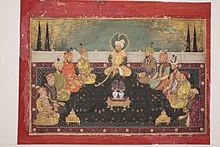Mughal dynasty
| House of Babur | |
|---|---|
Bahadur Shah II | |
| Titles | List
|
| Connected families | |
| Traditions |
|
| Dissolution | 1857 |
| Deposition | 21 September 1857 |
The Mughal dynasty (Persian: دودمان مغل; Dudmân-e Mughal) comprised the members of the imperial House of Babur (Persian: خاندانِ آلِ بابُر; Khāndān-e-Āl-e-Bābur), also known as the Gurkanis (Persian: گورکانیان; Gūrkāniyān),[1] who ruled the Mughal Empire from c. 1526 to 1857.
The Mughals originated as a
During much of the Empire's history, the emperor functioned as the absolute
The British tried and convicted the last emperor,
History
The Mughal empire is conventionally said to have been founded in 1526 by Babur, a Timurid prince from Andijan which today is in Uzbekistan. After losing his ancestral domains in Central Asia, Babur first established himself in Kabul and ultimately moved towards the Indian subcontinent.[10] Mughal rule was interrupted for 16 years by the Sur Emperors during Humayun's reign.[11] It is also though by Russian linguist, Vladimir Braginskiĭ, That the Hikayat Aceh literature from Aceh Sultanate were influenced by Mughal dynasty historiography, as he found out the literal structure similarities of Hikayat Aceh with Mahfuzat-i-Timuri, as the former has shared the similar theme with the latter about the lifetime and exploits of the protagonist of Mahfuzat-i-Timuri, Timur.[12] Braginskiĭ also found the similarities in structure of both Hikayat Aceh and Mahfuzat-i-Timuri with Akbarnama manuscript.[12]
The Mughal imperial structure was founded by
Around 1700, the dynasty was ruling the wealthiest empire in the world, with also the largest military on earth.[14] Mughals had approximately 24 percent share of world's economy and a military of one million soldiers.[15][16] At that time the Mughals ruled almost the whole of the South Asia with 160 million subjects, 23 percent of world's population.[17] The Dynasty's power rapidly dwindled during the 18th century with internal dynastic conflicts, incompatible monarchs, foreign invasions from Persians and Afghans, as well as revolts from Marathas, Sikh, Rajputs and regional Nawabs.[18][19] The power of the last emperor was limited only to the Walled city of Delhi.

Many of the Mughals had significant Indian Rajput and Persian ancestry through marriage alliances as they were born to Rajput and Persian princesses.
Succession to the throne

The Mughal dynasty operated under several basic premises: that the
Disputed headship of dynasty
The Mughal Emperors practiced polygamy. Besides their wives, they also had several concubines in their harem, who produced children. This makes it difficult to identify all the offspring of each emperor.[27]
A man in India named Habeebuddin Tucy claims to be a descendant of Bahadur Shah II, but his claim is not universally believed.[28]
Another woman named Sultana Begum who lives in the slums of Kolkata has claimed that her late husband, Mirza Mohammad Bedar Bakht was the great-grandson of Bahadur Shah II.[29]
Ziauddin Tucy is a sixth generation descendant of the last Mughal Emperor Bahadur Shah Zafar and today struggles to make ends meet. Living in a rented house, he still believes that the government will release properties of the erstwhile Mughals to the legal heirs. He also demands restoration of a Rs. 100 scholarships for Mughal descendants, that was discontinued by the government a while back. He wants that amount be raised to Rs 8,000. and that the government should grant the economically depressed Mughal descendants the money for their upliftment. Tucy has two unemployed sons and is currently living on pension.[30]
References
- ISBN 978-0-375-76137-9.
In India the dynasty always called itself Gurkani, after Temür's title Gurkân, the Persianized form of the Mongolian kürägän, 'son-in-law,' a title Temür assumed after his marriage to a Genghisid princess.
- ISBN 978-0-7922-3695-5.
- ISBN 978-0-226-34688-5.
- ^ Jeroen Duindam (2015), Dynasties: A Global History of Power, 1300–1800, page 105 Archived 6 December 2022 at the Wayback Machine, Cambridge University Press
- ISBN 978-8-189-83318-3.
- ISBN 9789384544980.
- ISBN 978-81-7156-817-8.
- ISBN 978-0-203-71253-5.
- ^ Bhatia, H.S. Justice System and Mutinies in British India. p. 204.
- ISBN 978-93-5118-093-7
- ISBN 90-04-02104-3. Retrieved 17 May 2020.
- ^ ISBN 978-90-04-48987-5. Retrieved 17 March 2024.
...author shares T. Iskandar's opinion that Hikayat Aceh was influenced by Mughal historiography..
- ^ "BBC - Religions - Islam: Mughal Empire (1500s, 1600s)". www.bbc.co.uk. Retrieved 15 June 2020.
- ISBN 9780415952798.
- ISBN 978-92-64-10414-3.
- ^ Art of Mughal Warfare." Art of Mughal Warfare. Indiannetzone, 25 August 2005.
- ISBN 9781135255800. Retrieved 17 May 2020.
- ISBN 978-0-8262-0222-2.
- ISBN 978-1-84331-004-4.
- ISBN 978-1-107-06068-5.
- ISBN 978-81-89833-18-3.
- ISBN 978-0-19-547643-9.
- ISBN 978-81-7022-524-9.
- JSTOR 3257119.
- ^ Asher 2003, p. 169
- ^ Bilal, Maaz Bin (9 November 2018). "Not just the last Mughal: Three ghazals by Bahadur Shah Zafar, the poet king". DAWN.COM. Retrieved 24 June 2020.
- ISBN 978-1-4088-0092-8.
- ^ Rao, Ch Sushil (18 August 2019). "Who is Prince Habeebuddin Tucy?". The Times of India. Retrieved 4 September 2022.
- ^ "Destitute Mughal empire 'heir' demands India 'return' Red Fort". www.aljazeera.com. Retrieved 4 September 2022.
- ^ Baseerat, Bushra (27 April 2010). "Royal descendant struggles for survival". The Times of India. Retrieved 4 September 2022.
Further reading
- Asher, Catherine Ella Blanshard (2003) [First published 1992]. Architecture of Mughal India. ISBN 978-0-521-26728-1.
